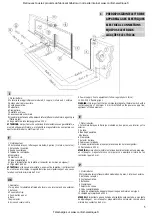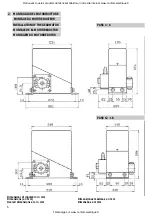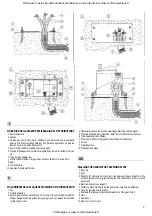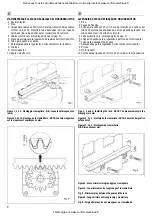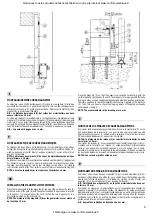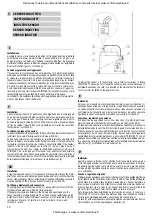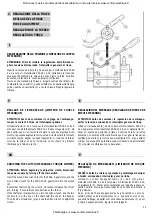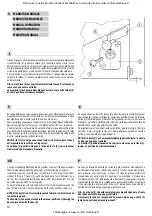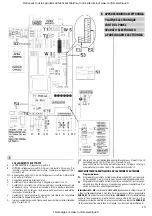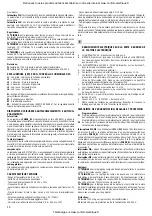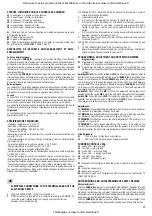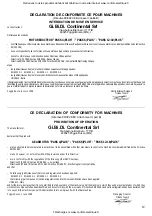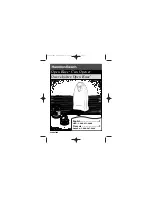
SPECIFICATIONS TECHNIQUES
-Plage des températures: -20 +70
°
C
-Humidité: < 95% sans condensation
-Tension d’alimentation: 220-230 V ± 10%
-Fréquence: 50-60 Hz
-Absorption maximale de la carte (moteur, voyants et pièces extérieurres non
compris): 70 mA
-Microinterruptions de secteur (charge maximale et tension d’alimentation
minimale): 20 mS
-Puissance maximale à la sortie du moteur: 1 CV (736 W)
-Charge maximale à la sortie du voyant: 12 V 3 W
-Charge maximale à la sortie du clignotant: 40 W
-Courant disponible à la sortie de l’alimentation de la cellule photo-electrique:
0,2 A 24 Vac ± 15%
-Toutes les entrées doivent être utilisées en tant que contacts propres, car
l’alimentation est produite à l’intérieur de la carte et arrangée de façon à assurer
le respect de l’isolation double ou renforcée par rapport aux pièces sous tension.
-Toutes les entrées sont gérées par un circuit intégré programmable (PAL).
-Si l’entrée de blocage reste ouverte, elle n’alimente pas la bobine des relais et
donc peut être utilisée pour bloquer inconditionnellement le moteur dans des
situations de danger por l’opérateur.
15
C/D
E
H
I
L
O
Q/R
S
T
P1
P2
VOYANTS LUMINEUX POUR LES CONTROLES SUIVANTS:
L1
- Voyant jaune - La carte est sous tension.
L2
- Voyant rouge - Moteur en fermeture.
L3
- Voyant vert - Moteur en ouverture.
L4
- Voyant vert - Commande d’ouverture.
L5
- Voyant rouge - Poussoir d’arrêt.
L6
- Voyant rouge - Cellule photo-électrique.
S1
- Carte des fins de course magnétiques, montée au-dessous de la carte
principale de la platine.
S2
- Carte du capteur inductif.
S3
- Carte du radiorécepteur.
S4
- Carte de l’embrayage électronique. Pour régler le couple du moteur agir
sur le trimmer T4 (UNIQUEMENT POUR PASS 4).
DISPOSITIFS DE SECURITE ANTI-ECRASEMENT ET ANTI-
ENTRAINEMENT
Cellule photo-électrique:
Si le programme
PGBDS_01
(conforme aux normes UNI 8612) est installé,
lorsque la cellule photo-électrique est interceptée en phase de fermeture de la
grille, celle-ci s’arrête et ne reprend son mouvement (en ouverture) que lorsque
la cellule est libérée. Lorsque la cellule est interceptée en phase d’ouverture de
la grille, celle-ci s’arrête et ne reprend son mouvement d’ouverture que lorsque
la cellule est libérée.
Si le programme
PGBDB_01
est installé, lorsque la cellule photo-électrique est
interceptée en phase de fermeture de la grille, celle-ci s’arrête et reprend son
mouvement (en ouverture) même si la cellule n’est pas libérée. En phase
d’ouverture la cellule photo-électrique n’est pas activée.
Barre palpeuse:
Les contacts N.F. de la barre palpeuse doivent être branchés en série au contact
N.F. de la commande d’arrêt sur la borne 11. Si la barre palpeuse est interceptée,
elle arrête le mouvement d’ouverture ou de fermeture de la grille.
Voyant:
Le voyant à 12 V (3 W MAXI.) s’allume au début de la phase d’ouverture et reste
allumé pendant toute la phase de pause. Au début de la phase de fermeture, il
commence à clignoter jusqu’à la fin de la fermeture, après quoi il s’éteint.
Si pendant le fonctionnement une impulsion d’arrêt est émise avant la fin de la
fermeture, le voyant devient fixe pour signaler que la grille est ouverte.
Clignotant:
Le fonctionnement du clignotant et le démarrage du moteur sont simultanés.
Alimentation à 220 V c.a.
UK
A
B
ELECTRICAL CONNECTIONS TO THE TERMINAL BOARD OF THE
ELECTRONIC DEVICE
220V FLASHING LIGHT: connect to terminals 1-2.
MOTOR: connect to terminals 3-4-5 of which terminal 4 is COMMON. To
invert the motor rotation direction, change over the connections
between the terminals 3 and 5.
POWER SUPPLY: 220-230V, 50-60 Hz. Connect to terminals 6-7 of which
terminal 6 is the neutral phase.
Main external earth wire.
N.C. contact of the stop button. Connect to terminals 11-13.
N.O. contact (terminals 10 and 13) of the button for the sequential open-
stop-close command or vice versa, or opening only when switch W5 is
closed; in this case closing can only be automatic if the switch W3 is
closed.
N.C. contact of the photoelectric cell safety device with photoelectric cell
powered. Connect to terminals 12 and 13.
Common input for buttons, indicator lights and safety device contact.
Terminals 9 and 13.
24 VAC output for powering the photoelectric cells etc. Terminals 15 and
16.
12 VDC indicator light (MAX 3 W). Terminals 14 and 13.
Radio receiver antenna coaxial cable. Connect the braiding or shielding to
terminal 18 and the central wire to terminal 17.
Programming:
Programmer mounted on radio receiver card (S3) for selection of channels
1 through 4. Not valid for self-learning receiver.
Programmer mounted on radio receiver card (S3) for setting the code
which must correspond to that of the transmitter. Not valid for self-learning
receiver.
PROGRAMMING, ADJUSTMENT AND PROTECTION DEVICES
Switches W1-W2:
The switches
W1
and
W2
must be closed between poles
2
and
3
if the microprocessor
M
with the program
PGBDS_01
is installed on the
device (in compliance with Italian
UNI8612
regulations, and the photoelectric
cell is active also in the opening phase), while they must be closed between
poles
1
and
2
if the microprocessor
M
with the program
PGBDB_01
is installed
on the device (the photoelectric cell is active only in the closing phase with
immediate inversion of the movement).
Switch W3:
When the switch
W3
is closed, the automatic closing function is
enabled. When the switch
W3
is open, the automatic closing function is disabled.
Switch W5:
When the switch
W5
is closed, the opening-only command is
enabled - see terminals 10 and 13. When the switch
W5
is open, the sequential
open-stop-close and vice versa command is enabled.
Adjustments:
T1 TRIMMER
for operating time adjustment which may vary from a minimum
of 5 seconds to a maximum of about 2 minutes.
T2 TRIMMER
for pause adjustment for automatic closing, which may vary from
a minimum of 2 seconds to a maximum of about 2 minutes.
T3 TRIMMER
for inductive sensor sensitivity adjustment. The trimmer T3 is
mounted on the card S2.
T4 TRIMMER
for motor torque adjustment. The trimmer is mounted on the
card S4. Before inserting the card, check that the jumper P is cut off. When
turning clockwise, the motor torque is decreased, when anti-clockwise increased.
Circuit breakers:
F1
T100 mA fuse for transformer protection.
F2
F5A fuse for 220-2340V power supply protection.
FUNCTION CONTROL LEDs:
L1
- yellow LED - card powered
L2
- red LED - motor closing
L3
- green LED - motor opening
L4
- green LED - opening command
L5
- red LED - stop button
L6
- red LED - photoelectric cell
S1 -
Magnetic limit switch card mounted on the master card of the electronic
device.
S2 -
Inductive sensor card
S3
-
Radio receiver card
S4 -
Electronic clutch card. To adjust the motor torque, act on the trimmer T4
(ONLY FOR PASS 4).
ANTI-CRUSHING AND ANTI-ENTRAINMENT SAFETY DEVICES
Photoelectric cell:
With the
PGBDS_01
program (in compliance with UNI8612 regulations), when
the photoelectric cell is intercepted with the gate in the closing phase, the gate
stops and restarts opening only when the photoelectric cell is freed; when the
photoelectric cell is intercepted in the opening phase, the gate stops and restarts
opening only when the photelectric cell is freed.
With the
PGBDB_01
program, when the photoelectric cell is intercepted in the
closing phase, the gate stops and restarts opening even if the photoelectric
Retrouvez tous les produits du fabricant Gibidi sur notre site internet www.confort-electrique.fr
Téléchargé sur www.confort-electrique.fr


